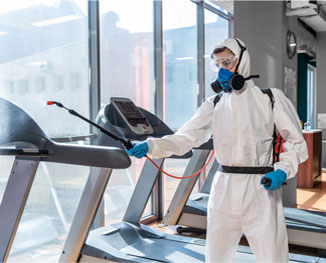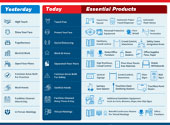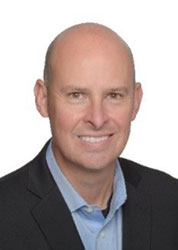Pandemic management is now a core competency in all walks of life.
Almost overnight, pandemic management has become a critical business capability and a part of everyone’s social responsibility, as we all work to protect the wellbeing of others. The impact of the pandemic will be lasting, but with a sound and flexible plan, you can ensure your business or school is ready and set for the future.
The “new normal” is no longer new. Pandemic management is now a core competency for businesses, schools, government entities, and personal lifestyles.
Schooling is now hybrid or part time attendance, and our personal shopping behaviors include face mask wearing, social distancing, and more of a focus on personal hygiene. Our office spaces have changed with the emergence of partitions, social distance signage, and hand sanitizers peppered throughout the space.
As the pandemic was emerging, businesses were focused on executing their plans for 2020 – driving customer experience, business development, and marketing execution. A global pandemic was the last thing on the radar, and the level of business disruption and closures it would cause was unimaginable.
What is pandemic management? The ability to protect your business environment, and ensure continuity during a pandemic. It encompasses the entire organization from employees to customers, to daily operations and your end-to-end supply chain. When COVID-19 hit, there was no pandemic management training or classes to lean on; no blueprint for navigating through this new unknown. It was a crisis of global proportion and needed to be treated as such. Businesses dusted off emergency preparedness plans, most of which were ill-equipped to address the specific needs of this pandemic, quickly pivoted operations, and learned on the fly. It was a real-time crash course for everyone, specifically essential businesses that were agile and flexible enough to remain open.
With no formal pandemic management plan in place, many businesses reacted on instinct, focused on re-opening, protecting employees, and continuing to serve customers in a safe and responsible manner. Initial uncertainties about how COVID-19 was spread, symptoms, and how to best keep the work place safe, made planning all the more difficult. In addition, the landgrab to stockpile emergency and personal protective equipment (PPE) supplies resulted in significant shortages of critical items, limiting businesses’ ability to respond quickly.
As health and social distance guidelines were established, and best practices put in place, businesses began to restore their operations, and schools started planning for their reopening. A new normal was established, which has become a part of our everyday lives. Businesses and schools around the world adapted new practices, including health and safety measures for all employees and students, as well as social distancing configuration for all spaces.

Taking preventative measures is an important step in creating a healthy, clean, and accessible workplace.
Teamwork and collaboration are fundamentals to a successful business ― more so now than ever before. Investing in the health of your business by creating a pandemic management plan that takes local, state, and federal guidelines into consideration ― without sacrificing productivity – has become a critical pillar for success. Some of the core elements of a strong pandemic management plan start with:
Room by Room Approach:
A room by room approach to ensure you are maintaining a safe environment in every space. From bathrooms, to offices, to work areas, lobbies and break rooms – what tools, processes and solutions do you need to implement to ensure your business continues to operate without interruption? If you have a COVID exposure, what are the step-by-step procedures to address and contain it within a specific area or operating pod, and restore operations quickly, efficiently and safely? Create a safety and wellness team if you haven’t already to manage cleaning protocols and office space signage and reminders.
Preventative Measures:
Taking preventative measures are an important step to create a healthy, clean, and accessible workplace. Whether you’re equipping restrooms with touchless faucets or providing convenient access to hand sanitizers when soap and water are unavailable, practicing good hygiene adds a layer of protection to the everyday routine.
PPE:
Ensuring a supply of PPE is essential for workplace safety, helping serve as a barrier between potential germs and airborne particulates. Reusable and disposable face masks, face shields, and gloves offer a variety of options to give your hands, eyes, nose, and mouth extra protection when interacting with others or handling frequently touched surfaces. If your business employs warehouse workers, make sure you have plenty of protective clothing on hand for each shift.
Flexibility:
No plan is foolproof; we don’t know what we don’t know. As health standards continue to evolve and change, procedures and policies need to adapt. Despite best efforts, employees may become sick. High-traffic areas and shared spaces may require extra care and attention. Clean and sanitary processes may need to be adjusted, and the use of scrubbers or quick-acting foggers required to enhance cleaning routines.
Transparency:
It’s important to communicate these changes to employees. If employees, or a portion of them, are remote, regular updates will keep them connected to the company and aligned with changing health and safety protocols. Our business leaders must ensure that employees have a voice in the company, so developing new attendance or sick leave policies may be in order to mitigate illnesses or to prevent an outbreak from an employee coming into work when they feel ill.
It is times like these when we reveal our character. What we have learned so far from 2020 is that we need to remain flexible, creative, and open to new ideas and new ways of doing things. This is how we grow.
COVID-19 has changed our present, and we need to adapt to a different future. We will likely operate in a world where face masks are the norm for restaurant staff, retailers, air travelers, and more. A world in which enhanced sanitation practices remain in place for years to come to align with customers’ elevated expectation of cleanliness, and where office locations will be serving a workforce operating in a hybrid environment.
We may never return to a pre-2020 world, so we need to plan accordingly, apply what we’ve learned, and integrate pandemic management into strategic planning in order to grow.

A room by room approach to adapting and protecting businesses and schools for the future.
Source: Global Industrial

Klaus Werner
About the Author
Klaus Werner is Senior Vice President and Chief Marketing Officer at Systemax [NYSE:SYX], a value-added industrial distributor going to market through its operating subsidiaries, primarily under the name Global Industrial and related brands. Mr. Werner has extensive experience in marketing, e-commerce, technology, data and enterprise analytics.
Scott Ellyson, CEO of East West Manufacturing, brings decades of global manufacturing and supply chain leadership to the conversation. In this episode, he shares practical insights on scaling operations, navigating complexity, and building resilient manufacturing networks in an increasingly connected world.